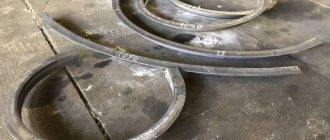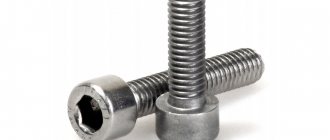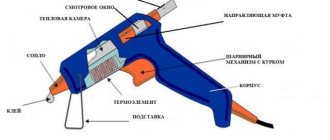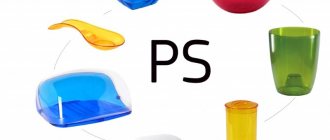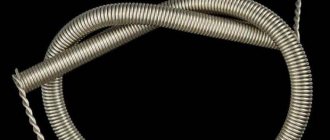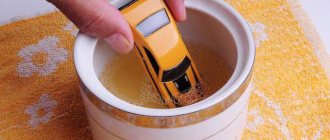08/14/2020Repair0
Arched openings are very popular not only in private houses, but also in large apartments. To decorate them and protect the edges from chipping, special overlays are used - plastic or metal corners. Metal is expensive and requires additional decorative finishing. Plastic is more popular, however, not every novice finisher knows how to bend a corner of this material under an arched opening.
- 1 Advantages of plastic corners
- 2 Ways to bend a corner
Important function of arched corners
Arched decorative corners
Finishing corners have been used for many years to simplify renovation work. It allows you to form corners and also protect the doorway. The main advantage of arched corners is the possibility of extending the service life of the finish, since with them the wallpaper will not break off at the corners and the paint will not be erased.
And if during the installation of an interior arch you need to plaster a corner made of chipboard or plasterboard, then an aluminum corner will allow you to display 90 degrees. Any home corner is subject to external influence, especially for arched openings - rearranging furniture or regular Saturday cleaning can damage it. There is a solution - glue a decorative corner.
Important! A perforated corner provides a smooth edge for a curved design. At the same time, the consumption of putties is reduced.
Thanks to perforation, the corner can not only be framed with clear lines, it can be bent and drawn into various shapes. The soft curved element makes it possible to design not only square or rounded arches in a classic style, but also to create semi-arches, as well as openings with non-standard bends. Arch corners have the following advantages:
- Affordable price.
- Practical - can be used in most interior solutions.
- Finish – produced in a wide range of colors.
- Installing decorative elements is not difficult.
Preparing the opening
At the beginning of work, measure the dimensions of the opening - in case you have to slightly change them. Drywall, putty and other materials are used to change the size or shape; if you plan to do this, then prepare the necessary materials in advance.
Now we need to prepare the surface. Clean the opening from dirt, seal all cracks and degrease the mounting area. Create as smooth and even a surface as possible, preferably by sanding and wiping it.
Before starting finishing work, the surface of the arched opening should be leveled as much as possible.
In cases where the opening is plastered, make sure the surface is smooth. If there are any cracks, chips, or unevenness, remove this layer and apply a new one. Then wait for it to dry completely and clean the surface and sand it.
Necessary tool
Liquid Nails
The plastic corner for the interior arch must be properly secured. For this purpose, a list of such tools is prepared in advance:
- Plastic element to match the style of the room.
- Assembly adhesive.
- Liquid nails will help attach the element.
- Rubber mallet.
Important! Gluing decor using liquid nails is simple, but risky. Firstly, the plastic can be damaged, and secondly, a large amount of material used leaves greasy marks on the finish.
It is best to attach a bent corner using assembly glue or liquid nails, since installation with metal nails or screws looks awkward and also increases the chances of cracks and chips.
Drywall is one of the most common materials for creating interior portals. It is lightweight, attached to the frame and makes it possible to draw internal and external radius corners. Since the material requires subsequent cladding, corners are used for ease of design. Glue for installation - putty.
Finishing an arch with a plastic corner (video)
Installation of decorative corners
Any apartment will look much more impressive if the edging of existing arches is decorated with plastic corners. Therefore, let's look at how to glue a plastic corner to an interior arch and make the frame durable and reliable.
There are two needs to use a PVC part: to glue and remove a right angle, or to paste over an arc. Condition for creating right angles:
- Surface treatment with a penetrating primer solution.
- Use a square to mark, mark and cut to the required size with a grinder.
- Apply the adhesive mixture to two inner planes of the element.
- Apply the strip, gently pressing it along its entire length.
First you need to level the surface of the opening
The flexible corner for the arcuate arch is fixed in a slightly different way. Photos and videos will help beginners understand the differences and features of installation. Installing such an element yourself will be no more difficult than the previous option, but pay attention to the following nuances:
- The width of the sides of the corner when finishing the arc varies. The wide side is laid on the end corner of the arch, and the narrow side is pressed against the wall.
- Silicone sealant or adhesive solution is applied to the element, as in the first case.
- You need to fasten it with several nails - a necessary measure, since the hot solution must completely set.
- Instead of nails, it is allowed to use masking tape - it secures the edge of the plastic corner.
Gluing a decorative corner
Important! It is prohibited to use a home or construction hair dryer to speed up drying, especially if photo wallpaper or paint is used for the walls.
Corners for interior arches are easy to glue onto wallpaper. The finishing material quickly sets with glue and allows you to test your strength the very next day. But if you want to cover an arch with an MDF corner, then use these tips:
- This type does not require additional fixation, but after applying glue to the corner and pressing it to the surface, wait a couple of seconds and then peel off the element again.
- After waiting for the glue to thicken, you can safely return it to its place. Usually 1-2 minutes is enough.
It is better to use a wooden corner for arched openings made of the same material. It is difficult to bend, so you can glue it on straight planes. Ideal use is rectangular portals where there is no round element.
Glue the plastic corner to the arch
Interesting! Among the abundance of finishing elements, you can choose cork, rubberized, rubber corners. A rolled and flexible rubber corner is simply necessary in places where water hitting the surface makes it slippery. These can be glued to tiles and concrete if necessary.
It is also possible to cover the arch using ordinary plastic corners, but in this case the elastic threshold will be much smaller. In order to bend the product to the desired size without damaging the product, you should heat the material with a hair dryer.
For the decorative design of arches and walls, polyurethane and polyurethane foam are used - in this case, all surfaces must be smooth. If there are small differences, then you need to glue the elements together by gently pressing and increasing the amount of glue in these places.
Simple ways to bend pipes
Do not despair if you have to install a complex structure using curved pipes, but there are no professional tools available. Even if you were unable to purchase blanks with the desired bending angle in advance, you can make parts for the work yourself, at home and with a minimum of tools.
How to proceed? Grab the structure with your hands, squeeze it tightly and gradually bend it. Proceed carefully so as not to damage the part. Smoothly, centimeter by centimeter, move along the length of the pipe. You need to repeat the manipulation in 5-6 approaches. Manual work is not suitable in all cases, since bending an aluminum pipe, for example, is much easier than doing the same with a metal product.
Advice: practice on an unnecessary section before starting “finishing” work. Act smoothly so as not to deform or break the part; the number of “approaches” depends on the diameter and length of the structure.
The manual method is effective when working with pipes with a diameter of 16-20 mm. With a larger cut, the process will be longer and more labor-intensive, but it is possible.
We've sorted out the aluminum, but how to bend a metal pipe yourself so that the result doesn't disappoint? A gas burner will solve the problem.
- We fix the metal piece in a vice.
- We warm up the area of the future bend.
- When scale appears, we begin bending.
How to determine when you can start working?
If the material is aluminum, hold a sheet of paper to the surface of the pipe. The signal will be if it ignites or produces smoke. If the other metal is metal, the heated area will turn red.
Please note: the heating method is not suitable for working with galvanized parts - damage to the coating is guaranteed and the coating will become unusable.
Tip: since it is more difficult to bend a square pipe without creases and deformation, use a powerful blowtorch or torch and heat all sides of the product before starting work.
We use fillers - sand and water
The use of fillers allows you to bend both corrugated pipe and large-diameter aluminum sections.
Principle of working with sand:
- pour sand inside the structure, put plugs on the ends of the pipe (watch for tightness);
- fix the part in a vice;
- We warm up the bending area with a soldering iron or gas torch;
- when the area heats up, bend the structure with a rubber mallet or a wooden mallet, gently tapping it on the heated surface;
- Upon completion of the manipulations, remove the plugs, remove the sand from the cavities - everything is ready.
Sand protects the pipe from deformation and uneven bending.
- Galvanized parts are bent in this way without heating
- Fill the cavities tightly so that the interior is filled to the brim.
- Treat square pipes on each side to help avoid unevenness.
The principle of working with water is almost identical - pour water into the part and install plugs. Before bending a PVC pipe or product made of other material, let the water freeze (expose it to frost or place it in the refrigerator). Once the liquid freezes, we apply the required bending radius to the structure using translational movements.
Using this principle, you can either bend a sheet of metal into a pipe (only without using water and sand), or bend the pipe itself.
Photo gallery of finished works
Well, gentlemen, novice finishers or home craftsmen, you still don’t know how to bend or fix bent components for building plastic * (PVC facing plastic)? Then you will definitely like this material! After all, only here will they teach you how to lay a plastic corner, L-shaped profile or F-shaped profile on an arch and tile, and indeed on any surface. BUT! Initially, the material was conceived to help those people who are still carrying out finishing work using plastic or carrying out partial dismantling of it, during which waves bend or appear on the corner, F-shaped profile, and especially at the start, or as it is also called the L-shaped profile.
So that everyone understands what we are talking about, I am attaching this photo.
I’ll tell you a little further about how to bend a plastic corner, and also along an arch, but now I would like to talk about how to align this corner, an L or F shaped plastic profile that has undergone some kind of deformation, not particularly critical!
I'll start with a small example.
In a toilet lined with plastic, it was necessary to get a long PVC panel clamped on both sides with a start (L-shaped profile). The plastic was on the front side, the toilet was standing flush against each other, and there was no other way to pull it out without additionally dismantling the entire right wall. Which is what I didn’t want to do. In general, using a heroic force, the plastic jumped out of the starting panel, bending it and making nicks and waves in it. It looked very ugly and it didn’t occur to me how to fix it without replacing the panel. Well, maybe cut out the place of deformation, at a loss of aesthetics! umnyestroiteli.ru
This is still a decent picture, since out of fright they leveled most of it with their hands; before that it was simply disgusting. So. What we did.
As it happens with a Russian person: - Laziness gives rise to ingenuity. I didn’t want to go to the store, and I didn’t want to spend money on starting either! Yes, and going through the entire right side of the node is not a “vein”. Taking an ordinary home hair dryer and turning it on to the third maximum speed, I brought it to the bent starting plastic.
And then a miracle happened. The waves formed on the L-shaped profile at the time of dismantling simply leveled out and the launch itself even seemed to hug the plastic panel a little. Yes, here’s the actual result, the still hot result in the photo below.
As you can see, all the deformation on the component has practically disappeared and everything doesn’t look so sad anymore. After further manipulations everything became even better!
As for the internal and external plastic corners, F-shaped profile, their deformation is corrected in the same way, using a hair dryer.
And now, actually, how to bend a plastic corner onto an arch, and for any decoration in principle.
High temperature bending: features of the hot bending method
To give the desired shape to a non-standard plastic pipe, you should prepare:
- Spring to maintain the inner diameter, or sand.
- Construction hair dryer: it is advisable to buy equipment with multi-stage temperature control so as not to overheat the plastic.
- Forming machine: a board or piece of chipboard panel with clamps attached along the planned shape of the pipe.
- Blanks along the radius from bars.
Bars for bend template
Instructions: bending pipe step by step
How to bend a PVC sewer pipe without damaging the walls? Before you begin, you should fill the internal gap. A spring or a thick-walled metal pipe is inserted inside the pipe. Some craftsmen advise pouring sand and soldering or capping the edges.
But during heating, grains of sand can stick to the inner walls, which is why dirt will constantly accumulate at the bend.
After filling, the pipe is fixed on the machine with clamps. If possible, you need to put on a silicone molding sleeve so that the walls are not scratched during operation.
After attaching to the machine, radius templates are installed in the planned locations.
Carefully heat the walls along the entire diameter with a hairdryer, bending the pipe according to the template. It is very important not to overheat the surface - PVC melts already at 130 o, polypropylene - at 150 o. Bending must be done very slowly so that sagging and folds do not form on the lower edge of the bend.
Bent Hot Pipe
The bent pipe must be left in a fixed state until it cools completely. Only after this can you check whether the resulting bend corresponds to the planned one.
Result: how to check the quality and integrity of the fold
The quality of the work can be assessed immediately: if the resulting bend does not visually change the shape of the section, the walls are smooth, without folds or cracks, then everything was done correctly.
Ideal radius of PVC pipe
If the walls have melted due to heating, become significantly thinner, and there are pronounced folds on the lower edge, then such a pipe will have to be thrown away. Irregularities on the inner surface and severe deformation of the section are the reason that plaque will accumulate inside the bend, which will lead to clogging.
You can check the tightness of the area by filling the pipe with water. But it is impossible to accurately predict how long a bent plastic sewer pipe will remain sealed. As the pressure inside the system increases, the thinned walls may crack, and microcracks will appear over time.
How to bend a plastic corner: along an arch, tile, or any surface!
We are already savvy and know for sure that we will need a hairdryer for this. On many construction sites I advise you to bend plastic corners using a hair dryer. But in the previous example, we were perfectly convinced that an ordinary household hair dryer with three speeds would be suitable. This is due to the fact that the plastic corner itself is made of thin PVC * and begins to bend, taking into account the fact that it is not fixed and nothing presses on it, even from direct rays of the sun. You should have seen this in hardware stores with large windows that let in the light. They sell corners there that are so wavy that the parrots can rest. And this is a direct violation of the storage of plastic products! So.
Bend a plastic corner along an arch is as easy as shelling pears. You will need to run it along the arch and at the moment of greatest tension, simply heat it slightly in the place we need, until the stress on the bend is completely removed, so that the corner can move further along the arch without any problems. As a rule, these are three places in which the plastic corner will need to be bent. This takes into account the fact that at home you have an ordinary, not a figured arch.
Well, let's look at these places in the picture below.
As you can see, in a regular arch there are three potential zones where you will have to bend the plastic corner. But that is not all. You may encounter such a problem that you will have to use a hair dryer around the entire perimeter of the arch. Don't worry, this is normal. Heat the corner with a hairdryer not too much, the main thing is to lay it around the entire perimeter without white kinks. And then once you glue it, only then will you go through it one more time to eliminate minor or major defects. The corner will definitely fit around the perimeter as it should.
Bending a plastic corner on a semi-arch is also very simple, even easier than on a regular arch. Since she only has TWO places where she needs to bend it!
More complex arches, in my opinion, are not framed with a plastic corner, since there are special panels and slats for this. Well, finally, something interesting.
The material “How to bend a plastic corner” was sent by our regular reader and expanded by the administration of the site Construction from A to Z. Enakievo-Donetsk *.
https://www.umnyestroiteli.ru
Master's answer:
Real materials intended for finishing are reliable and durable. But the most valuable qualities are combined in plastic corners. They are made from solid polyvinyl chloride, and they are sheets of plastic with a given specific width. In accordance with the technology, plastic corners are obtained after bending plastic sheets exactly at an angle of 90 degrees. Thanks to a number of additives to the original plastic, the corner is extremely durable and flexible at the same time.
In order to give the plastic corner the required shape, you will need the corner itself, a powerful hair dryer that produces very hot air. Also stock up on a sharp knife and sealant (liquid nails).
It happens that you need to change the shape of a corner, for example, edging an arch. In order to change the shape of a plastic corner, you need to heat it to a certain temperature, without resorting to open fire. It is best to use a construction hair dryer, and if you don’t have one, heat the plastic with a regular hair dryer or hot water.
When the corner has warmed up thoroughly, then, without hesitating for a second, apply it to the joint of adjacent surfaces, previously coated with liquid nails or sealant. As soon as you “plant” the corner, hold it for a while so that it exactly takes the shape you require. During the cooling process, the material will exactly repeat the bends and convexities of the surface.
It is to create beautiful arched structures in the interior of an apartment that manufacturers produce special corner arched elements. The design of these elements is designed in such a way that there are many notches on it, allowing you to bend the plastic corner, adjusting it to an arch with any diameter. The corner arched elements are fixed in the same way as plastic corners - using liquid nails and sealants.
In order to create complex geometric shapes, you need to cut the ribs on a plastic corner with an interval of 0.5 cm opposite each other and so that there is a mandatory offset of the cuts in relation to each other. It is very easy to bend this shape, but there is one caveat - the structure itself is fragile, and if you cut it longer than it should, the corner will break. In addition to all this, the decoration of the corner will suffer, so such actions can be carried out in the place of the corner where it will be primed or puttied.
Installation of plastic corners is very simple. The corners can be fixed with liquid nails, sealant, or ordinary metal nails. Plastic corners are very easy to clean, even using household chemicals. They are waterproof, nonflammable, durable and resistant to any mechanical damage.
Plastic corners are used in different areas. They protect joints and external corners from cracks and damage, and increase their strength. They also contain a decorative element, which is used in the manufacture of furniture. But the most important thing is that PVC corners are absolutely environmentally friendly and do not harm human health.
The arch in the interior serves both as decoration and determines the quality of the apartment’s renovation. Its shape and finish highlight the style. The location in a high traffic area requires protection of the protruding elements of the opening. Decorative corners for wallpaper will help to beautifully emphasize the shape and strengthen the arch; decorative corners for wallpaper will help create a holistic image. They can also be used on painted surfaces.
Corners for arches for wallpaper
Pipe bending equipment
Plane-parallel plates
If heating and cooling is not your thing, use a parallel plate. A primitive, but trouble-free and proven method.
A plate is a curved piece of wood or metal with a groove. Suitable for working with steel and metal-plastic products with a diameter of up to 45 mm.
- We place the pipe in a clamp on a plane-parallel plate and fix it (clamp it).
- We bend it, repeating the shape of the workpiece along the groove, and remove it.
A fast, reliable method that does not require large expenses. The disadvantage of using plane-parallel plates is the unchangeable curvature of the workpiece. The use of plates with different radii of curvature will help solve the problem. A steel structure will also give in.
The peculiarity of the method is the limitation in length; the shape of short tubes can be easily changed, but it will not be possible to accurately bend a product whose length exceeds the length of the workpiece.
Let's look at how to bend a pipe into a spiral with your own hands or give the product an angle of up to 90°.
It is better to use a metal spring for working with parts made of ductile non-ferrous metals. The spring prevents deformation of the structure. The choice of size depends on the internal “girth” of the tube.
- Insert the spring into the part (insert until it bends).
- Gradually add a bend at the knee or by first clamping the structure in a vice.
The spring simplifies the process by taking the compression/tension force and load onto itself. When working with soft, pliable materials, choose springs of medium hardness and small diameter. Precautionary measures will prevent the part from bursting or tearing.
Please note: Before placing the steel spring inside the pipe, attach a strong cord or long wire to one of its ends. This step will make it easier to remove the spring after bending.
Bending of metal sheets and pipes is also carried out using a grinder. Welding is a radical method that solves the problem if other options are not suitable for objective reasons. The required tools are a welding machine and a grinder.
- Make calculations - estimate the radius of curvature of the product (to be sure, you can sketch out a drawing and make markings on the part).
- Three transverse cuts are made along the length of the bent section (on three sides).
- The details give a bend.
- The sawn sections are welded.
- The bent end of the pipe at the welding site is ground, removing “sawdust” and irregularities.
The bend is neat, aesthetic and durable.
As you can see, there are enough answers to the question of how to bend a pipe - choosing the method that is relevant to solve your problems will not be difficult. All you need is the right tool and desire. Consider the diameter of the product, its length and the material with which you will be working.
The above methods have two disadvantages:
- Possibility of product damage, breakage and ruptures.
- Getting a uniform, aesthetic curve at home is problematic.
There is only one way to insure yourself against troubles if you do not have the skills and experience in pipe bending work - to hire a professional.
If you have no desire or opportunity to use the services of a specialist, do not despair. Before starting the event, carefully study the mat. part, watch videos or master classes from professional builders (there are plenty of them on the Internet).
Clear lines and protection from destruction are obtained thanks to the edging
Wallpapered and painted outer corners are the first to begin to deteriorate. As people pass by, they cling with their shoulders and legs, and hit the protruding elements with various objects. I advised my friend, who was finishing his renovation, to stick up a corner for wallpaper. In his house, figured arches separate the kitchen and dining room, zone the large living room, and separate the hallway from the corridor.
Finishing the arch with corners
The pasted edges of the arch without additional finishing are visually blurred and merge with the background. The easiest way to make a line clear and turn it into interior decoration is with the help of a decorative profile. It is flexible, made from:
- plastic;
- metal;
- laminated cork.
Decorative plastic profiles are used more often than others. It is painted during manufacture. Has a uniform cut tonality. It bends easily and hides surface defects and irregularities.
Metal corners are used for edging arches in modern techno, hi-tech, art deco, and avant-garde styles. They are made of aluminum strip 0.3 - 0.8 mm thick with a decorative coating:
- spraying;
- chrome plating;
- lamination.
The surface can have any color. The most popular ones are steel, black metal and mirror ones.
Cork wallpaper corners are rarely used. It is mounted on arches with a large arch radius. They are used in interiors with wallpaper and panels made of similar material. A profile made from natural bark is more expensive than plastic and metal materials.
Arched profiles are divided according to purpose:
- perforated plaster;
- decorative.
For corners whose rotation is greater or less than 900, special flexible corners are produced from laminated cardboard and plastic.
Cold bending method: instructions and limitations
The manual cold bending method is suitable for changing the shape of metal and metal-plastic thin-walled pipes with a diameter of up to 32 mm. To bend such an internal sewer pipe, you will need:
- Special spring selected according to the inner diameter.
Spring: allows minimal deformation of the internal lumen
- If you don’t have time to search and buy a spring, you can use sand. Additionally, you will have to make plugs for the ends - from plastic, wood, cork.
- Factory blanks are used as a template to create the required radius, or cones glued from cut chipboard sheets are used.
Thin sewer pipes can be bent without special clamps. For products made of hard alloys or thick-walled pipes, special equipment is used: hydraulic machines (bending products up to 60 mm), electromechanical machines (for parts with a diameter of 60 mm).
Professional machine for creating complex shapes
The spring is placed inside the pipe section. Both ends of the spring must be free. If the diameter of the spring is smaller than the diameter of the pipe, the ends can be secured with clamps. After installing the pipe bender, they begin to slowly bend the product.
You need to bend the pipe gradually - the material (especially metal-plastic and polyethylene) returns to its previous position, so a larger radius is created. Thin sections are bent by hand; for products of larger diameter, a clamp or template is used.
Rolling radius on template
Perforated profile for arches
Arch and corners for it under wallpaper
The corner of the arch can be finished if it is smooth, without changes and does not go to the side. To do this, special perforated corners are installed during putty:
- plastic;
- metal;
- cardboard.
One side of the profile consists of segments. When bent, they easily fan out or compress, taking the desired shape, and adhere to the surface of the arch and figured multi-level ceiling. When putting putty they serve as beacons. Attach them:
- construction stapler;
- nails;
- adhesive composition.
When renovating indoors, plastic corners are mainly used. Outside the house it is more practical to use metal ones. Cardboard is rarely found on sharp and obtuse corners under wallpaper in the interior.
The use of a plaster profile makes the lines of the arches correct and the transitions of the planes clear. The trellises and paint lie flat. At the same time, perforated profiles strengthen the corners and protect the finishing material from destruction and chipping.
An alternative to mechanical action: how to bend a pipe
It is better to assemble complex areas from factory parts. Finished products are sealed, have an ideal diameter, and are equipped with insulating gaskets. Even a person without training can assemble a bend of the most complex shape.
Ready-made parts for assembling a pipeline of complex shape
Alternative to mechanical bending:
Flexible sewer pipes: application
Installing a corrugated hose is justified if you need to install it in tight niches - under a bathtub, washbasin. It is also advisable to install corrugated drains for household appliances in places where it is not possible to lay a rigid pipeline. Advantages: low cost and ease of installation. The main material of manufacture is PVC.
Corrugation under the bath bowl
The disadvantage of flexible sewer hoses is the presence of ribs on the walls. Plaque quickly accumulates on the folds of the corrugation, and threads cling to the protrusions. Corrugated areas are the most common places for blockages to form and the main cause of unpleasant odors.
Large diameter bends
To avoid problems with flexible wiring, craftsmen recommend installing removable fasteners - clamps instead of sealant. In this case, you can easily disconnect the hose for cleaning or replacement.
Connections and bends for thick-walled sewer pipes
Complex distribution of prefabricated pipelines
When planning a home sewer line, it is better to provide alternative options for bypassing the projections. To form complex pipeline structures, select:
- Elbows with a standard angle of inclination to ensure the correct flow rate inside the bend.
- Adapters and turns - for arranging points of direction change.
- Fittings and inspections - installed at points with the greatest risk of clogging.
An example of arranging a non-standard pipeline in difficult conditions
Definitely, if there is the slightest opportunity to avoid bending sewer pipes, it is worth taking advantage of it. The variety of factory products allows you to find the optimal solution even in difficult situations. If it is impossible to install a rigid pipeline, it is better to install a corrugated pipe with the possibility of regular replacement. It is strictly not recommended to bend plastic products of large diameter, especially if you plan to install a branch in a screed or under a plasterboard panel - it will be difficult to find and eliminate the leak. It is impossible to repair or seal a bent plastic pipe; the entire section will have to be replaced. If you cannot do without bending, then it is better to entrust the process of bending and installation to a specialist.
- Popular
Do-it-yourself heating, water supply and sewerage
What you can do with your own hands
Variety of decorative corners
Corners for wallpaper for arches
You can choose corners for wallpaper that match or contrast. It all depends on the style and desire to emphasize the arch line. Plastic corners created for arches have different sides:
- 9 x 16 mm;
- 10 x 20 mm;
- 13 x 16 mm;
- 15 x 30 mm.
There is no specific standard regulating the size of the sides. Each manufacturer produces a wallpaper corner in a width ratio that it considers convenient. In addition, the profile length ranges from 2700 mm to 3000 mm. Equilateral corners are also used to decorate the arch. They start from a side size of 10 mm and end with 50 mm. Their thickness is 1 – 1.4 mm. Wider trims are custom made for a specific arch.
The thickness of the plastic profile for finishing arches is usually one millimeter. This is enough so that the wallpaper corner can hide unevenness and remain flexible. In addition to plain colored ones, they can be painted to match various types of wood, metal, and stone.
Attention! When purchasing, pay attention to the bending radius. Its minimum size by which a decorative corner can be bent without destroying it and creating extreme stress.
What size and color to choose for a certain style
Arch in the interior of the apartment
You can make the corners neat without highlighting the arches in the interior using a narrow profile matched to the background color of the wallpaper. A contrasting dark edging will emphasize the shape of the opening and concentrate attention on it. For folk and natural styles, decorative plastic wood-look corners are used.
The smaller the room and the arch, the narrower and more inconspicuous the corner should be. Contrasting bright finishes make the interior expressive and visually reduce the space.
The tone profile should match one of the three colors most often used in wallpaper designs.
Installation of decorative arched corners
Corners for the arch to the room
The decorative arched corner is installed last during renovation, when the wallpaper is glued and dry. It can be attached in various ways:
- self-tapping screws into holes with a cone for the heads;
- carnations with cut off heads;
- adhesive composition for plastic;
- liquid Nails.
I use self-tapping screws when decorating interiors in loft and industrial styles. In this case, they are elements of thematic design.
I never use nails. If they become clogged, the plastic may crack. Even if the caps are cut off, traces of the fasteners are visible. It is difficult to match the mastic exactly to the tone of the finish and to disguise the nails.
Attention! Remove strips of wallpaper half the width of the profile and glue the corners directly to the putty.
Arch and corners for wallpaper
I install the corners for the arch with glue mainly on painted surfaces and thick washable wallpaper.
- I cut the wallpaper on both sides of the corner with a sharp knife.
- I cut and check the fit of the dry profile. I mark the middle of the corner and arch.
- I adjust the joints. I'm rechecking their alignment.
- I apply a small amount of glue to the middle of the profile.
- I start gluing from the middle. I press the corner and secure it with tape to the wall.
- After the glue dries, I remove the tape.
Advice! If the length of the profile is not enough to completely cover the arch, add it symmetrically on both sides. This will look more aesthetically pleasing than the usual “sharpening” in one place.
I use liquid nails most often when finishing glued arches. Preparation is similar to gluing. I only apply liquid nails pointwise, press for a few seconds and move further - from the middle to the right, then to the left and down. The quick hardening of the composition does not require fixation with tape and long pressing with hands.
The working process
If you want to achieve a good result, then you need to have all the necessary materials and tools at hand. We will only discuss the wallpapering stage; you must prepare the surface in advance. The base must be dry and level.
Materials and tools
The following materials are needed for work:
Sometimes the arch is highlighted with wallpaper of a different color. Another option is to paint the surface of the arch; in this case, instead of wallpaper, you will need paint of a certain color.
For an arched structure, if you will paste it separately, it is better to prepare the composition a little thicker than for smooth walls. When cooking, use 10% less water to obtain the desired consistency.
I recommend using a special primer for wallpaper. It not only strengthens the walls, but also paints them white, creating an ideal base for wallpapering.
If the corner is attached under the wallpaper, then a special version of small thickness is used, which has a small protrusion to form the contour of the arch.
Tool for work:
Construction knife. You need a very sharp version with a hard blade 25 mm wide. In addition to the knife, be sure to purchase a set of spare blades. A good option is a tool with segmented blades; they are very rigid and cut very accurately;
A sharp knife allows you to perfectly cut wallpaper along the edge of the arch
Brush for applying glue. You need an option with thick pile to distribute the composition evenly and quickly. The most commonly used is a poplar, but ordinary options with a width of 10 cm or more can also be used;
The Maklovitz brush is very suitable for applying thick wallpaper paste.
Brush for leveling wallpaper. Since the surface of the arch is uneven, using a spatula to press the wallpaper is not very convenient, as it can damage the material. It is much better to use a special brush; it is 30 cm wide and provides quick and convenient leveling even on semicircular surfaces;
A brush is needed to level the wallpaper on the surface, press it and remove excess adhesive.
Scissors. With their help, it is very convenient to make cuts on the edges of the wallpaper when folding it, if the folding technology is used. It is also convenient to use scissors to cut wallpaper sheets into pieces of the desired size.
To work with wallpaper you need comfortable, massive scissors.
The working process
Let's figure out how to paste over a door arch:
You can continue work after the surface has completely dried. This usually takes from 1 to 3 hours.
If the arch is small in width, then it is sealed with two sheets with a joint in the middle.
Some types of wallpaper also require adhesive to be applied to the wall. In this case, the composition is distributed along the base. The instructions on the packaging with the composition will tell you whether this is necessary.
A strip about 20 mm wide is left along the edge
Special precision is not needed, it is important that the protrusion is more or less even along the entire length of the edge

